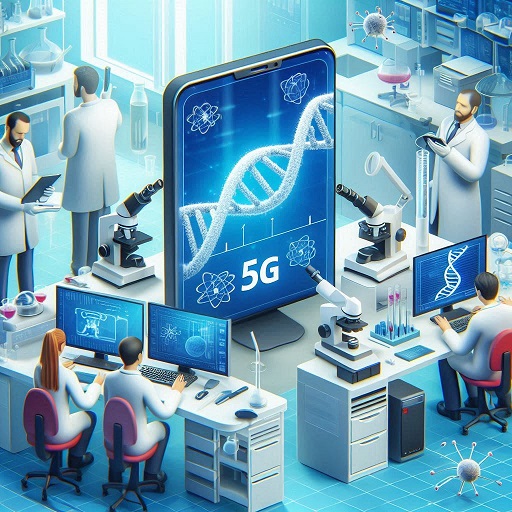The advent of 5G technology promises to revolutionize how we connect, communicate, and interact with devices. Testing in this field plays a crucial role in achieving the performance goals of 5G networks. With applications in IoT, autonomous vehicles, and high-speed mobile broadband, device testing ensures that 5G-enabled devices deliver optimal user experiences.
5G device testing guarantees the quality, compatibility, and performance of devices across various applications. Given the complexity of 5G networks, rigorous testing is essential to identify and address potential issues before widespread deployment.

The Global 5G Device Testing Market Overview
The global 5G device testing market is expected to reach USD 1.7 billion by 2028, with a compound annual growth rate (CAGR) of 7.0% during the forecast period. A significant factor contributing to this growth is the substantial investment being made in 5G deployment. As more industries and consumers adopt 5G technology, the demand for thorough and efficient device testing will continue to rise, driving market expansion.
Download PDF Brochure @ https://www.marketsandmarkets.com/pdfdownloadNew.asp?id=208174946
Key Components of 5G Device Testing
5G device testing incorporates several components, from network protocols to hardware requirements. Testing requires specialized equipment and software to simulate real-world conditions and ensure each device operates efficiently within a 5G environment.
Types of 5G Device Testing
Different testing types, such as functional, performance, security, and interoperability testing, cater to unique aspects of 5G devices. Functional testing ensures all device features work correctly, while performance testing assesses network speed, latency, and reliability.
Network Performance Testing
Network performance testing is central to validating 5G networks, as it involves measuring data speeds, latency, and network reliability under various conditions. This type of testing ensures consistent user experience across different devices and network setups.
Application Performance Testing
With the demands of 5G applications in mind, testing is essential to evaluate device performance for applications like streaming, gaming, and high-quality video calls. The low-latency and high-speed advantages of 5G need rigorous assessment to maintain optimal functionality for these applications.
Interoperability Testing
Interoperability testing verifies that 5G devices function seamlessly with various networks and providers, ensuring users can switch providers without compatibility issues. This testing also confirms compatibility with legacy networks, a crucial factor in widespread 5G adoption.
Compliance Testing
Compliance testing addresses adherence to industry standards, regulatory guidelines, and certifications required for 5G devices. This testing is essential for legal compliance, ensuring devices meet safety, environmental, and performance standards.
Security Testing for 5G Devices
Security testing identifies vulnerabilities within 5G devices, safeguarding against breaches and cyber threats. As 5G becomes integral to critical applications like healthcare and finance, robust security testing is paramount to protect user data and privacy.
Testing 5G in IoT Applications
5G has significant applications in IoT, enhancing device connectivity, reducing latency, and supporting large-scale deployments. Testing for IoT applications ensures seamless interaction and high performance for smart homes, wearables, and industrial IoT devices.
5G Testing for Autonomous Vehicles
Autonomous vehicles rely heavily on fast, reliable connectivity to operate safely. Testing ensures vehicles respond swiftly to environmental changes, highlighting 5G’s role in autonomous driving.
Testing for Enhanced Mobile Broadband (eMBB)
eMBB applications rely on the high-speed, high-bandwidth potential of 5G, from HD video streaming to augmented reality experiences. Testing in this area validates the network’s ability to handle high-data demands without performance degradation.
Testing for Ultra-Reliable Low-Latency Communication (URLLC)
Mission-critical applications, such as remote surgeries or industrial automation, require ultra-reliable communication with minimal latency. Testing URLLC applications ensures that these devices operate with high precision and dependability.
Key Challenges in 5G Device Testing
Challenges in 5G testing include high costs, technical complexity, and the demand for new infrastructure. As 5G technology continues to evolve, overcoming these obstacles is essential for widespread 5G adoption and effective device testing.
Emerging trends in 5G testing include the use of AI and machine learning to enhance testing processes. Automation, predictive analysis, and virtual testing environments represent the future of 5G device testing, ensuring faster and more accurate results.
FAQs
- Why is 5G device testing important?
5G device testing ensures that devices perform optimally across various applications and networks, improving user experience and device reliability. - What are the primary types of 5G device testing?
Testing includes functional, performance, security, interoperability, and compliance tests, each assessing unique device aspects. - How does 5G impact IoT device performance?
5G enhances IoT devices by providing faster speeds, lower latency, and improved connectivity, crucial for large-scale IoT applications. - What is URLLC in 5G testing?
URLLC stands for Ultra-Reliable Low-Latency Communication, essential for mission-critical applications like remote surgeries. - How does interoperability testing benefit 5G users?
Interoperability testing allows seamless switching between providers and ensures compatibility with legacy networks, enhancing 5G usability. - What challenges are associated with 5G testing?
Challenges include infrastructure costs, technical complexity, and the need for advanced testing tools to handle 5G’s unique requirements.
